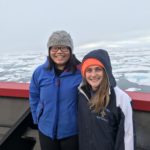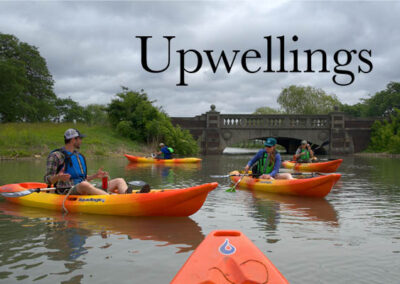
The sentiment feels so clichéd, we hardly need to say it: Where did summer go? Somehow, we’re already rounding the corner toward another school year, another autumn, another transition. But don’t pack away the tackle boxes and swimsuits just yet! Bask in the late summer sunshine, enjoy those last few weekends at the beach, and check out the news from Michigan Sea Grant.
Collaboration and connecting the dots are key goals for new outreach specialist
By Cindy Hudson, Michigan Sea Grant Extension communications manager
 Michigan Sea Grant is pleased to welcome Chiara Zuccarino-Crowe as a new Michigan State University Extension outreach specialist.
Michigan Sea Grant is pleased to welcome Chiara Zuccarino-Crowe as a new Michigan State University Extension outreach specialist.
Chiara (pronounced key-ata) will forge and enhance partnerships around the Great Lakes region. She will assist in program planning, evaluation, and information-sharing among Great Lakes stakeholders and partners by working closely with staff at the NOAA Great Lakes Environmental Research Laboratory (GLERL), national and regional Sea Grant programs, and Michigan State University Extension.
“Chiara Zuccarino-Crowe’s work experiences with NOAA, nonprofits, and educational programming, as well as her science background in biology and fisheries and wildlife, make her an excellent choice to help us develop this new position,” says Heather Triezenberg, Michigan Sea Grant Extension specialist and program leader.
Chiara started her new position on August 13. She is based in Ann Arbor at GLERL but also will spend time at Michigan Sea Grant’s MSU Extension office in East Lansing.
Chiara received her B.A. in biology from Boston College and her M.S. in Fisheries and Wildlife from MSU. In 2014, she was awarded a competitive Sea Grant Knauss Fellowship and spent a year working with NOAA’s Office of National Marine Sanctuaries in Silver Spring, Maryland. In the years following her fellowship, she has continued to serve the National Marine Sanctuary System as a tourism and recreation coordinator through a partnership with the National Marine Sanctuary Foundation.

“Chiara will be a great addition to our Sea Grant network,” says Michigan Sea Grant Associate Director Bill Taylor. “She understands how important it is to collaborate in interdisciplinary teams of interested publics to find solutions to environmental issues that facilitates their future sustainability.”
Collaborating and networking among stakeholders and partners will be a large part of Chiara’s new position. “I love opportunities to combine a mixture of research, education, outreach, and community development,” she says, “especially because there is a greater likelihood of both conservation and economic success when incorporating communities from the start. I’m looking forward to trying to connect the dots in new ways.”
Deborah Lee, director of GLERL, says she is looking forward to having Chiara join the team. “Our mission is to conduct research on Great Lakes ecosystems and to help inform resource use and decisions regarding their management. It’s important not only to communicate research out, but also to listen to what the needs are. GLERL’s link to the Great Lakes Sea Grant network is an imperative to achieve that two-way communication. Chiara is also a welcome member to NOAA’s Great Lakes Regional Collaboration Team that strives to strengthen NOAA’s impact in the region.”
Contact information:
Email: [email protected]
Office phone: (734) 741-2363
NOAA, Great Lakes Environmental Research Laboratory
4840 South State Road
Ann Arbor, MI 48108-9719
News from our fellows

Research fellow Corey Krabbenhoft spends a lot her of time in waders, an array of monitoring instruments and sampling jars at her fingertips. This time, she checks in from the Upper Peninsula to let us know about a related project she’s working on. Read her post here.

Perhaps unwilling to endure another day of Washington, D.C.’s sweltering summer, Knauss fellow Janet Hsiao sought out some Arctic cold. No, really — she’s currently on board a research vessel off the coast of Alaska. Read about her adventures here.
New recipes and restaurants highlighted on Freshwater Feasts!

Smoked cisco chowder, some assembly required. Photo: Ellen George
Be sure to visit our food blog, Freshwater Feasts, for Great Lakes seafood recipes, cooking tips, restaurant highlights, guest posts from fisheries researchers, and more!
New resources to increase resilience in Saginaw Bay, other vulnerable coastal communities

Floods affected homes in Saginaw Bay’s Bangor Township in June 2017. Photo: Kip Cronk
By Meaghan Gass, Michigan Sea Grant Extension educator for Saginaw Bay
In June 2017, a storm caused major flooding and damage to roads, homes, businesses, and agriculture in the Saginaw Bay region. Extreme storms contribute to issues such as erosion, runoff pollution, infrastructure instability, and crop damage. The land-use patterns and topography in the Saginaw Bay watershed increase the region’s vulnerability to these issues.
Responding to these emergencies requires focus and resources. It is equally important to invest in preparing communities before hazards occur. Michigan Sea Grant, Michigan State University Extension, and a host of local partners have been working together to improve community resiliency, which in this instance refers to a community’s ability to adapt to and recover quickly from extreme storms.
Decision-makers across the Saginaw Bay watershed’s 22 counties participated in a 2015 survey to explore views of extreme storms and their local impacts. Building on the survey results, Michigan Sea Grant and partners created educational materials to support community resiliency and increase understanding of the impacts of extreme storms and flooding.
While these resources focus on Saginaw Bay, the principles and resources are widely applicable to any community at risk of extreme storms and flooding. The resources include three fact sheets, a webpage, and three recorded webinars.

Even a little extra water can hamper daily activities, such as this high-water incident at Huron Metropark. Photo: Todd Marsee
- Extreme storms in the Saginaw Bay region impact public health, community safety, and economic stability (PDF)
- Tools to increase awareness of stormwater during extreme storms (PDF)
- Tools to assess risks from extreme storms in the Saginaw Bay region (PDF)
- Webpage dedicated to stories and images from the Great Flood of 1986, which greatly impacted the Saginaw Bay region.
- In the NOAA Digital Coast Partnership: Using data to support community resiliency webinar, viewers learn about the NOAA Digital Coast Partnership and how the available data and tools help communities address coastal issues. Some of the tools discussed included the Lake Level Viewer, Coastal County Snapshots, Land Cover Atlas, and green infrastructure in the Great Lakes.
- During the Extreme Storms and Hazard Mitigation Strategies webinar, viewers learn about different types of hazards, including extreme storms and flooding, and mitigation planning support and resources.
- In the National Flood Insurance Program’s Community Rating System webinar, participants learn about how communities can reduce flood insurance premiums for local property owners by completing flood protection activities through the CRS.
Calling all marinas!

Marina owners and operators, the Michigan Clean Marina Program wants to hear from you! Your feedback can help revise the online classroom, update the certification process, and tailor future educational opportunities. Access the survey by Friday, September 7 through the relevant link below — and share widely!
But wait — there’s more! The first 40 certified marinas who respond to the survey will receive a Clean Marina goodie bag, complete with hats, fuel bibs, boat show tickets, and more. The first 20 non-certified marinas who take the survey will be able to register for the Clean Marina online classroom without a pledge fee ($100 value). These gifts will also be sent to marinas that have already responded to the survey.
- Survey for certified Clean Marinas
- Survey for non-certified marinas
4-H camps encourage kids to get involved in fishing, citizen science
Every summer, Michigan Sea Grant Extension staff host a variety of 4-H camps that engage kids in activities such as sailing, water sampling, invasive species mapping, fishing, and more. Check out a few of this summer’s photos — and watch our events calendar next year to sign your child up for an exciting new adventure!
- Ypsilanti New Tech High School. Great Lakes lesson on climate. NSF Climate Project
#CrayWeek

The striking Cherax pulcher may be native to a single stream system in Indonesia — and was just one of the many crayfish species celebrated during #CrayWeek. Photo: Christian Lukhaup
The Discovery Channel may have Shark Week, but during the final week of July, the freshwater world clicks its claws for a smaller — but no less intriguing — creature: the crayfish.
July 30 through August 3 marked Michigan Sea Grant’s second annual #CrayWeek, a social media bonanza celebrating all things related to these freshwater crustaceans. The blitz was conceived in 2017 to highlight news stories about newly discovered populations of invasive red swamp crayfish in southern Michigan. The #CrayWeek hashtag quickly drew participation from crayfish researchers and enthusiasts around the country, and a new tradition was born.
This year, Michigan Sea Grant rallied fellow cray-ficionados to share articles, facts, and photos about these diverse, understudied, and occasionally problematic creatures. And share they did! Crayfish fans from 10 countries and 23 U.S. states used the #CrayWeek hashtag in 300 Twitter posts, which reached more than 331,000 unique users.
Check out a couple of the week’s posts below, and search for #CrayWeek on Twitter to get the full array:



From Extension
Michigan Sea Grant Extension educators write informative articles on a variety of subjects — from special events on Beaver Island to important tools in the fight against invasive species. Below are some of their articles from the past few weeks.
 Database provides a diverse toolkit for the fight against aquatic invaders
Database provides a diverse toolkit for the fight against aquatic invaders
By Rochelle Sturtevant
Learn how to use the online list generator to find which species have become established in your watershed.
 Great Lakes Fisheries Heritage Trails Conference offers an island experience
Great Lakes Fisheries Heritage Trails Conference offers an island experience
By Brandon Schroeder
Travel to Beaver Island to explore online opportunities for expanding the heritage trail network across Michigan and the Great Lakes region.
 Farmers are needed to test EnviroImpact tool
Farmers are needed to test EnviroImpact tool
By Meaghan Gass
With the tool, farmers can better determine when to apply manure as a fertilizer source with lower runoff risks.
 Salmon run offers unique fish-watching opportunities for nature enthusiasts
Salmon run offers unique fish-watching opportunities for nature enthusiasts
By Dan O’Keefe
Visit weirs and dams in west Michigan this fall or watch a new video to enjoy the spectacle.






